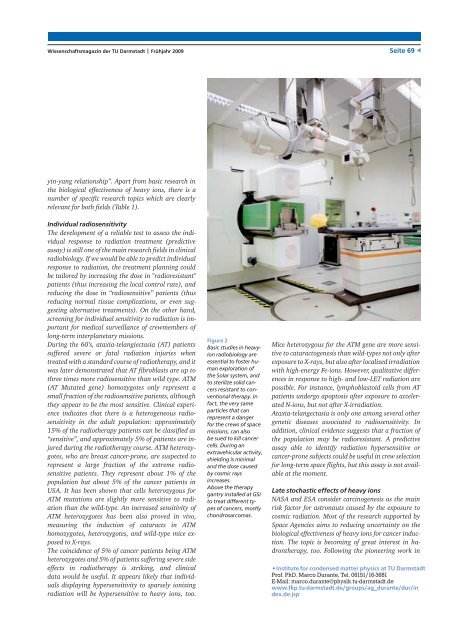forschen 1/2009 - Forschungscluster «Nuclear and Radiation Science
forschen 1/2009 - Forschungscluster «Nuclear and Radiation Science
forschen 1/2009 - Forschungscluster «Nuclear and Radiation Science
Sie wollen auch ein ePaper? Erhöhen Sie die Reichweite Ihrer Titel.
YUMPU macht aus Druck-PDFs automatisch weboptimierte ePaper, die Google liebt.
Wissenschaftsmagazin der TU Darmstadt | Frühjahr <strong>2009</strong><br />
yin-yang relationship”. Apart from basic research in<br />
the biological effectiveness of heavy ions, there is a<br />
number of specific research topics which are clearly<br />
relevant for both fields (Table 1).<br />
Individual radiosensitivity<br />
The development of a reliable test to assess the individual<br />
response to radiation treatment (predictive<br />
assay) is still one of the main research fields in clinical<br />
radiobiology. If we would be able to predict individual<br />
response to radiation, the treatment planning could<br />
be tailored by increasing the dose in "radioresistant"<br />
patients (thus increasing the local control rate), <strong>and</strong><br />
reducing the dose in “radiosensitive” patients (thus<br />
reducing normal tissue complications, or even suggesting<br />
alternative treatments). On the other h<strong>and</strong>,<br />
screening for individual sensitivity to radiation is important<br />
for medical surveillance of crewmembers of<br />
long-term interplanetary missions.<br />
During the 60’s, ataxia-telangiectasia (AT) patients<br />
suffered severe or fatal radiation injuries when<br />
treated with a st<strong>and</strong>ard course of radiotherapy, <strong>and</strong> it<br />
was later demonstrated that AT fibroblasts are up to<br />
three times more radiosensitive than wild type. ATM<br />
(AT Mutated gene) homozygotes only represent a<br />
small fraction of the radiosensitive patients, although<br />
they appear to be the most sensitive. Clinical experience<br />
indicates that there is a heterogeneous radiosensitivity<br />
in the adult population: approximately<br />
15% of the radiotherapy patients can be classified as<br />
“sensitive”, <strong>and</strong> approximately 5% of patients are injured<br />
during the radiotherapy course. ATM heterozygotes,<br />
who are breast cancer-prone, are suspected to<br />
represent a large fraction of the extreme radiosensitive<br />
patients. They represent about 1% of the<br />
population but about 5% of the cancer patients in<br />
USA. It has been shown that cells heterozygous for<br />
ATM mutations are slightly more sensitive to radiation<br />
than the wild-type. An increased sensitivity of<br />
ATM heterozygotes has been also proved in vivo,<br />
measuring the induction of cataracts in ATM<br />
homozygotes, heterozygotes, <strong>and</strong> wild-type mice exposed<br />
to X-rays.<br />
The coincidence of 5% of cancer patients being ATM<br />
heterozygotes <strong>and</strong> 5% of patients suffering severe side<br />
effects in radiotherapy is striking, <strong>and</strong> clinical<br />
data would be useful. It appears likely that individuals<br />
displaying hypersensitivity to sparsely ionizing<br />
radiation will be hypersensitive to heavy ions, too.<br />
Figure 2<br />
Basic studies in heavyion<br />
radiobiology are<br />
essential to foster human<br />
exploration of<br />
the Solar system, <strong>and</strong><br />
to sterilize solid cancers<br />
resistant to conventional<br />
therapy. In<br />
fact, the very same<br />
particles that can<br />
represent a danger<br />
for the crews of space<br />
missions, can also<br />
be sued to kill cancer<br />
cells. During an<br />
extravehicular activity,<br />
shielding is minimal<br />
<strong>and</strong> the dose caused<br />
by cosmic rays<br />
increases.<br />
Above the therapy<br />
gantry installed at GSI<br />
to treat different types<br />
of cancers, mostly<br />
chondrosarcomas.<br />
Seite 69 ◀<br />
Mice heterozygous for the ATM gene are more sensitive<br />
to cataractogenesis than wild-types not only after<br />
exposure to X-rays, but also after localized irradiation<br />
with high-energy Fe-ions. However, qualitative differences<br />
in response to high- <strong>and</strong> low-LET radiation are<br />
possible. For instance, lymphoblastoid cells from AT<br />
patients undergo apoptosis after exposure to accelerated<br />
N-ions, but not after X-irradiation.<br />
Ataxia-telangectasia is only one among several other<br />
genetic diseases associated to radiosensitivity. In<br />
addition, clinical evidence suggests that a fraction of<br />
the population may be radioresistant. A predictive<br />
assay able to identify radiation hypersensitive or<br />
cancer-prone subjects could be useful in crew selection<br />
for long-term space flights, but this assay is not available<br />
at the moment.<br />
Late stochastic effects of heavy ions<br />
NASA <strong>and</strong> ESA consider carcinogenesis as the main<br />
risk factor for astronauts caused by the exposure to<br />
cosmic radiation. Most of the research supported by<br />
Space Agencies aims to reducing uncertainty on the<br />
biological effectiveness of heavy ions for cancer induction.<br />
The topic is becoming of great interest in hadrontherapy,<br />
too. Following the pioneering work in<br />
•Institute for condensed matter physics at TU Darmstadt<br />
Prof. PhD. Marco Durante, Tel. 06151/16-3681<br />
E-Mail: marco.durante@physik.tu-darmstadt.de<br />
www.fkp.tu-darmstadt.de/groups/ag_durante/dur/in<br />
dex.de.jsp


